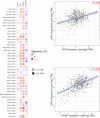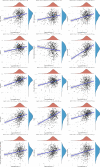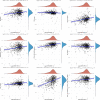Ubiquitin-specific peptidase 10, a deubiquitinating enzyme: Assessing its role in tumor prognosis and immune response
- PMID: 36248971
- PMCID: PMC9554417
- DOI: 10.3389/fonc.2022.990195
Ubiquitin-specific peptidase 10, a deubiquitinating enzyme: Assessing its role in tumor prognosis and immune response
Abstract
Ubiquitin-specific peptidase 10 (USP10) is a member of the ubiquitin-specific protease family that removes the ubiquitin chain from ubiquitin-conjugated protein substrates. We performed a literature search to evaluate the structure and biological activity of USP10, summarize its role in tumorigenesis and tumor progression, and discuss how USP10 may act as a tumor suppressor or a tumor-promoting gene depending on its mechanism of action. Subsequently, we elaborated further on these results through bioinformatics analysis. We demonstrated that abnormal expression of USP10 is related to tumorigenesis in various types of cancer, including liver, lung, ovarian, breast, prostate, and gastric cancers and acute myeloid leukemia. Meanwhile, in certain cancers, increased USP10 expression is associated with tumor suppression. USP10 was downregulated in kidney renal clear cell carcinoma (KIRC) and associated with reduced overall survival in patients with KIRC. In contrast, USP10 upregulation was associated with poor prognosis in head and neck squamous cell carcinoma (HNSC). In addition, we elucidated the novel role of USP10 in the regulation of tumor immunity in KIRC and HNSC through bioinformatics analysis. We identified several signaling pathways to be significantly associated with USP10 expression, such as ferroptosis, PI3K/AKT/mTOR, TGF-β, and G2/M checkpoint. In summary, this review outlines the role of USP10 in various forms of cancer, discusses the relevance of USP10 inhibitors in anti-tumor therapies, and highlights the potential function of USP10 in regulating the immune responses of tumors.
Keywords: USP10 inhibitors; deubiquitination; epigenetic modification; immune response; tumorigenesis.
Copyright © 2022 Ye, Chen, Huang, Xuan and Zheng.
Conflict of interest statement
The authors declare that the research was conducted in the absence of any commercial or financial relationships that could be construed as a potential conflict of interest.
Figures








Similar articles
-
USP10 as a Potential Therapeutic Target in Human Cancers.Genes (Basel). 2022 May 6;13(5):831. doi: 10.3390/genes13050831. Genes (Basel). 2022. PMID: 35627217 Free PMC article. Review.
-
USP10 suppresses tumor progression by inhibiting mTOR activation in hepatocellular carcinoma.Cancer Lett. 2018 Nov 1;436:139-148. doi: 10.1016/j.canlet.2018.07.032. Epub 2018 Jul 26. Cancer Lett. 2018. PMID: 30056112
-
Ubiquitin-specific peptidase 7 (USP7) and USP10 mediate deubiquitination of human NHE3 regulating its expression and activity.FASEB J. 2020 Dec;34(12):16476-16488. doi: 10.1096/fj.202001875R. Epub 2020 Oct 23. FASEB J. 2020. PMID: 33095475 Free PMC article.
-
LPAR2 correlated with different prognosis and immune cell infiltration in head and neck squamous cell carcinoma and kidney renal clear cell carcinoma.Hereditas. 2022 Mar 4;159(1):16. doi: 10.1186/s41065-022-00229-w. Hereditas. 2022. PMID: 35241179 Free PMC article.
-
Good or not good: Role of miR-18a in cancer biology.Rep Pract Oncol Radiother. 2020 Sep-Oct;25(5):808-819. doi: 10.1016/j.rpor.2020.07.006. Epub 2020 Aug 12. Rep Pract Oncol Radiother. 2020. PMID: 32884453 Free PMC article. Review.
Cited by
-
Loss of USP10 promotes hepatocellular carcinoma proliferation by regulating the serine synthesis pathway through inhibition of LKB1 activity.Cancer Sci. 2024 Dec;115(12):3902-3914. doi: 10.1111/cas.16336. Epub 2024 Sep 26. Cancer Sci. 2024. PMID: 39327097 Free PMC article.
-
NOTCH1 signaling is dysregulated by loss of the deubiquitinase USP28 with del(11q), uncovering USP28 inhibition as novel therapeutic target in CLL.Leukemia. 2025 Aug;39(8):1892-1904. doi: 10.1038/s41375-025-02632-4. Epub 2025 Jun 2. Leukemia. 2025. PMID: 40456839 Free PMC article.
-
Roles of deubiquitinases in urologic cancers (Review).Oncol Lett. 2024 Oct 14;28(6):609. doi: 10.3892/ol.2024.14743. eCollection 2024 Dec. Oncol Lett. 2024. PMID: 39525605 Free PMC article. Review.
-
Protein ubiquitination in ovarian cancer immunotherapy: The progress and therapeutic strategy.Genes Dis. 2023 Oct 29;11(6):101158. doi: 10.1016/j.gendis.2023.101158. eCollection 2024 Nov. Genes Dis. 2023. PMID: 39253578 Free PMC article. Review.
-
Comprehensive analysis of the role of ubiquitin-specific peptidases in colorectal cancer: A systematic review.World J Gastrointest Oncol. 2024 Jan 15;16(1):197-213. doi: 10.4251/wjgo.v16.i1.197. World J Gastrointest Oncol. 2024. PMID: 38292842 Free PMC article.
References
Publication types
LinkOut - more resources
Full Text Sources
Other Literature Sources
Research Materials
Miscellaneous

